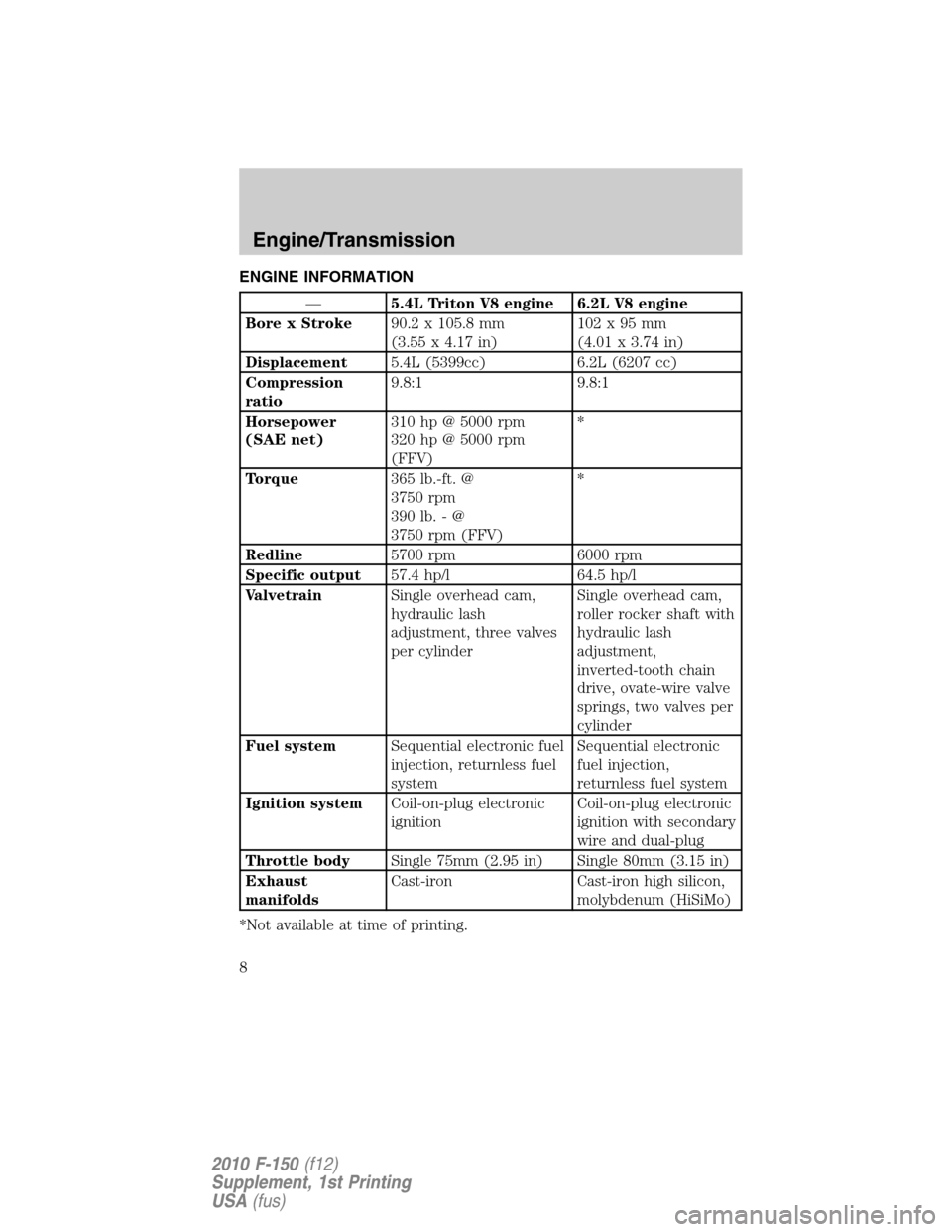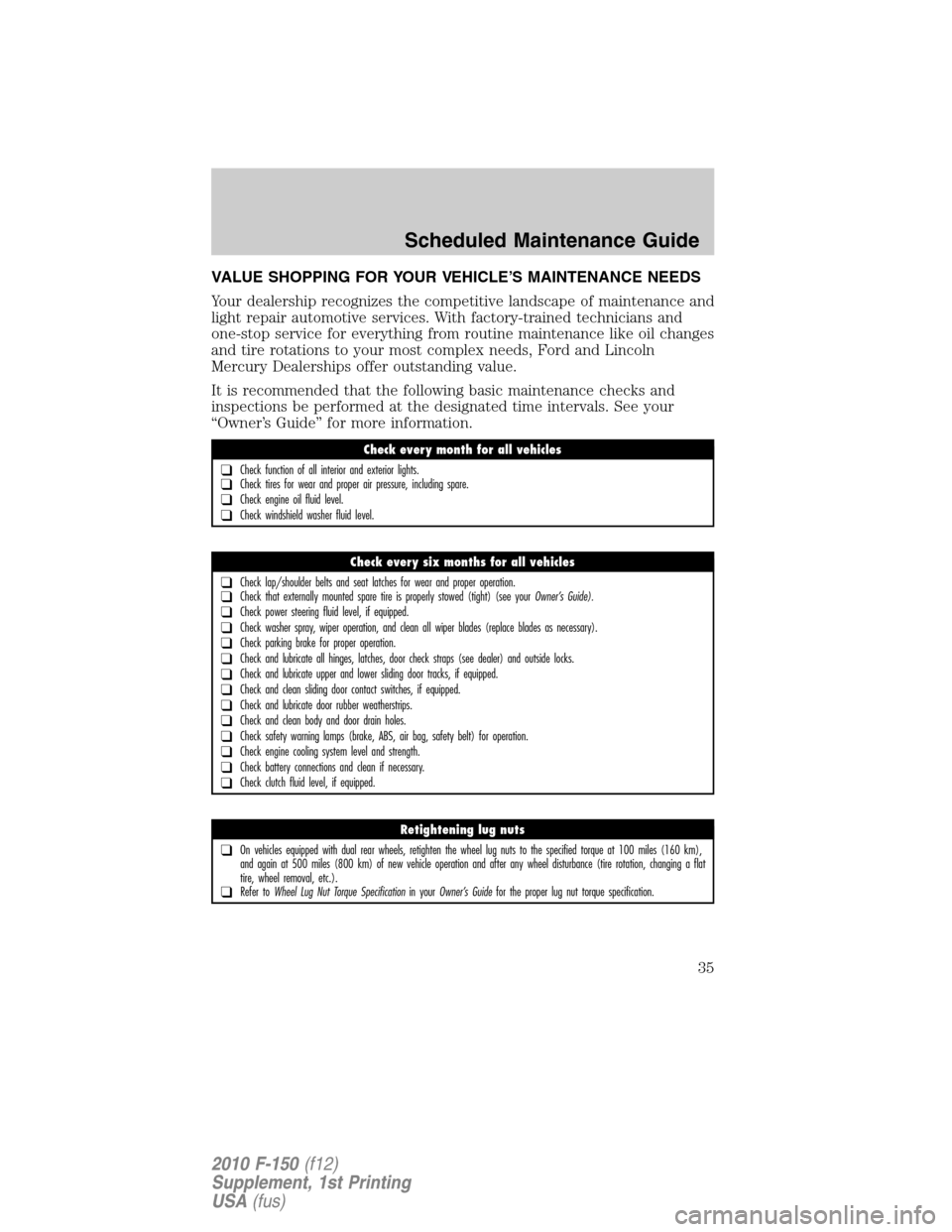Page 8 of 57

ENGINE INFORMATION
—5.4L Triton V8 engine 6.2L V8 engine
Bore x Stroke90.2 x 105.8 mm
(3.55 x 4.17 in)102x95mm
(4.01 x 3.74 in)
Displacement5.4L (5399cc) 6.2L (6207 cc)
Compression
ratio9.8:1 9.8:1
Horsepower
(SAE net)310 hp @ 5000 rpm
320 hp @ 5000 rpm
(FFV)*
Torque365 lb.-ft. @
3750 rpm
390 lb. - @
3750 rpm (FFV)*
Redline5700 rpm 6000 rpm
Specific output57.4 hp/l 64.5 hp/l
ValvetrainSingle overhead cam,
hydraulic lash
adjustment, three valves
per cylinderSingle overhead cam,
roller rocker shaft with
hydraulic lash
adjustment,
inverted-tooth chain
drive, ovate-wire valve
springs, two valves per
cylinder
Fuel systemSequential electronic fuel
injection, returnless fuel
systemSequential electronic
fuel injection,
returnless fuel system
Ignition systemCoil-on-plug electronic
ignitionCoil-on-plug electronic
ignition with secondary
wire and dual-plug
Throttle bodySingle 75mm (2.95 in) Single 80mm (3.15 in)
Exhaust
manifoldsCast-iron Cast-iron high silicon,
molybdenum (HiSiMo)
*Not available at time of printing.
Engine/Transmission
8
2010 F-150(f12)
Supplement, 1st Printing
USA(fus)
Page 19 of 57

•While driving in desert conditions, the midpoint of the day is the most
difficult time to see many of the small ridges and dips due to�flat
shadows�from the sun being at its highest point. Extreme care should
be taken at these times to not inadvertently run into these obstacles.
•It is highly encouraged that you switch to off-road mode and perform
an�AdvanceTrac single press�to ensure improved off-road braking
performance under these conditions. Be sure to disengage the
�off-road mode�and switch back to�AdvanceTrac key-on mode�before
performing any street driving. Please see the Off-road mode section of
this supplement for more details.
After off-road driving
It is important to complete a full vehicle inspection after off-road driving.
Some items to check include:
•Ensure that tires are inflated to proper tire pressure as indicated on
the tire placard.
•Check the wheels and undercarriage for built up mud or debris which
can cause vehicle vibration.
•Ensure that the grille and radiator are clear of any obstructions that
may effect cooling.
•Ensure that the brakes are in proper working order and free of any
mud, stones etc., which can become trapped around the brake rotor,
backing plate and caliper.
•Check that the air filter is clean and dry.
•Inspect for torn or punctured boots on ball joints, half shafts, steering
gears.
•Inspect exhaust system for damage or looseness.
•Inspect undercarriage fasteners. If any are loose or damaged, tighten
or replace ensuring that the proper torque specification is used.
•Inspect the tires for any cuts in the tread or sidewall area. Also
inspect the sidewall for any bulge indicating damage to the tire.
•Inspect the wheels for dents, cracks, or other damage.
Driving
19
2010 F-150(f12)
Supplement, 1st Printing
USA(fus)
Page 27 of 57

•Extra caution should be taken when operating the vehicle near its
maximum load, including assuring proper tire pressure and reducing
speeds.
•In the event that you encounter an abnormally harsh impact, inspect
your tires for damage.
•Inspect your tires for damage on a regular basis. If a tire is damaged,
replace it immediately.
•Proper suspension alignment is critical for maximum performance and
optimal tire wear. If you notice uneven tire wear, have your alignment
checked.
•Your SVT vehicle follows a more stringent tire rotation schedule as
compared to the base F-150. Refer toSpecial operating conditions
(off-road operation)in theScheduled maintenance guidefor more
information.
•When replacing tires, the only way to assure original performance is to
use the original equipment tire. If a different tire is used, it should be
the same size, speed rating and load rating.
WHEELS
Your SVT vehicle is equipped with unique wheels matched to the tires.
To avoid damage to your wheels:
•Maintain proper tire pressure (see “Tires” previously listed).
•Due to extreme tire/wheel width, this vehicle cannot be taken through
an automatic car wash that uses mechanical tracks, as wheel damage
may result.
•When installing wheels, always torque lug nuts to specification with a
torque wrench.
•Inspect your wheels for damage on a regular basis. If a wheel is
damaged, replace it immediately.
•In the event that you encounter an abnormally harsh impact, inspect
the outer diameter of your wheels, both inside and out, for damage.
Tire Information
27
2010 F-150(f12)
Supplement, 1st Printing
USA(fus)
Page 35 of 57

VALUE SHOPPING FOR YOUR VEHICLE’S MAINTENANCE NEEDS
Your dealership recognizes the competitive landscape of maintenance and
light repair automotive services. With factory-trained technicians and
one-stop service for everything from routine maintenance like oil changes
and tire rotations to your most complex needs, Ford and Lincoln
Mercury Dealerships offer outstanding value.
It is recommended that the following basic maintenance checks and
inspections be performed at the designated time intervals. See your
“Owner’s Guide” for more information.
Check every month for all vehicles
❑Check function of all interior and exterior lights.❑Check tires for wear and proper air pressure, including spare.
❑Check engine oil fluid level.
❑Check windshield washer fluid level.
Check every six months for all vehicles
❑Check lap/shoulder belts and seat latches for wear and proper operation.❑Check that externally mounted spare tire is properly stowed (tight) (see yourOwner’s Guide).
❑Check power steering fluid level, if equipped.
❑Check washer spray, wiper operation, and clean all wiper blades (replace blades as necessary).
❑Check parking brake for proper operation.
❑Check and lubricate all hinges, latches, door check straps (see dealer) and outside locks.
❑Check and lubricate upper and lower sliding door tracks, if equipped.
❑Check and clean sliding door contact switches, if equipped.
❑Check and lubricate door rubber weatherstrips.
❑Check and clean body and door drain holes.
❑Check safety warning lamps (brake, ABS, air bag, safety belt) for operation.
❑Check engine cooling system level and strength.
❑Check battery connections and clean if necessary.
❑Check clutch fluid level, if equipped.
Retightening lug nuts
❑On vehicles equipped with dual rear wheels, retighten the wheel lug nuts to the specified torque at 100 miles (160 km),
and again at 500 miles (800 km) of new vehicle operation and after any wheel disturbance (tire rotation, changing a flat
tire, wheel removal, etc.).
❑Refer toWheel Lug Nut Torque Specificationin yourOwner’s Guidefor the proper lug nut torque specification.
Scheduled Maintenance Guide
35
2010 F-150(f12)
Supplement, 1st Printing
USA(fus)